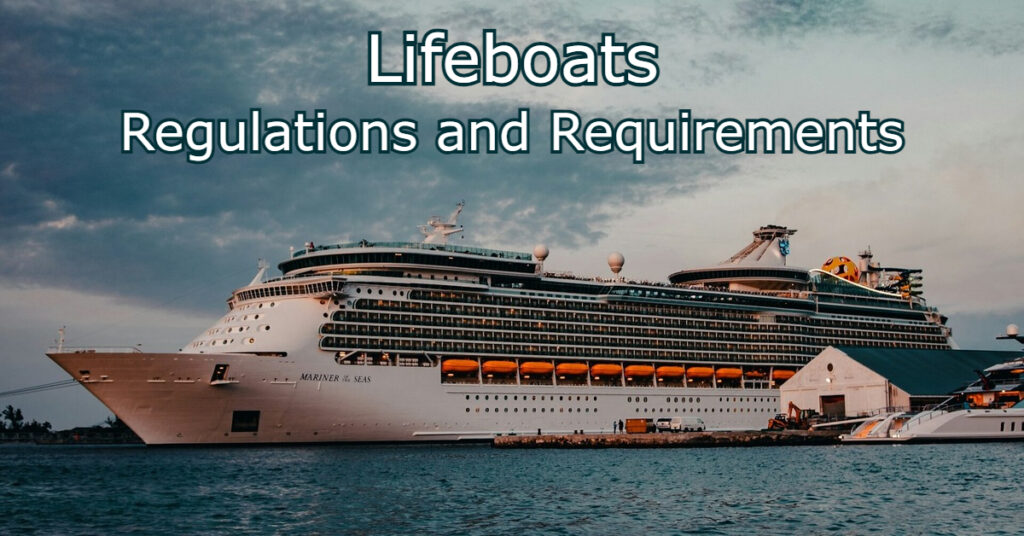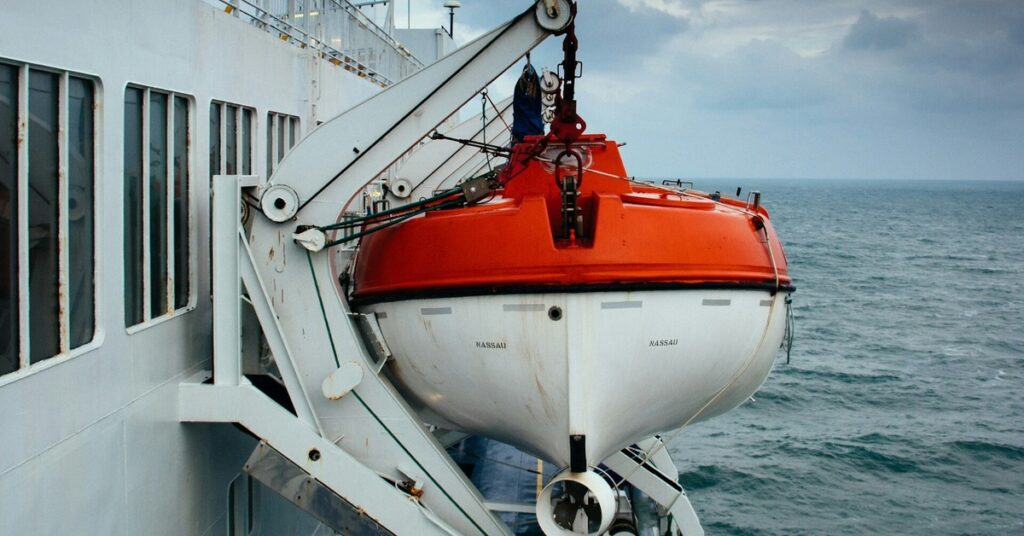In an emergency, portable vessels called lifeboats will get a ship’s occupants to relative safety. They are smaller vessels to which a ship’s passengers or crew can escape, which are then deployed separately from the main ship. So how do lifeboats work?
By law, all lifeboats should be adequately constructed, following stringent regulations and requirements, to ensure they are sufficient to protect human life. However, the regulations that govern lifeboat construction, maintenance and operation are more complex.
Understanding these guidelines, even as a passenger or temporary occupant, will ensure that everyone remains safe and can make more knowledgeable decisions about the sea vessels they travel on. For example, people can briefly inspect lifeboats before a journey, report a problem, or get off the ship if something is awry.

The Basics of Lifeboat Construction and Maintenance
A lifeboat is a smaller, alternative vessel meant to be a temporary extension of the main ship. In an emergency, such as if the main ship is stranded, sinking or colliding with another vessel or object, the lifeboats give occupants a safe method of escape.
Since they are an emergency measure, a stringent set of rules and regulations govern what constitutes a lifeboat and their maintenance, especially on passenger vessels like cruise ships, ferries or transports.
A lifeboat’s expected carrying capacity should be at most 150 to 300 persons or, collectively, 150% of the total passengers onboard — no lifeboat will be approved to carry more than that number. Additional guidelines establish spaces and seating arrangements, an average weight of 75 kg per person and access to life vests for every occupant onboard.
Most essential is a lifeboat’s construction, maintenance and operation. According to the International Life-Saving Appliance (LSA) code, a properly constructed lifeboat must have ample stability in a seaway and sufficient freeboard when fully loaded, regardless of whether the brunt of the weight is made up of passengers or equipment. Moreover, lifeboats should be made of rigid hulls and capable of retaining positive stability, which is defined as being upright in calm water.
Construction guidelines establish a standard for lifeboat strength, buoyancy, carrying capacities, propulsion, fittings — like a rudder and a tiller — and onboard equipment. Onboard equipment is called “deck machinery” on large ships and vessels.
All lifeboat hulls and covers should be fire-retardant and non-combustible. Occupants should have seating, whether thwarts, benches, or fixed chairs. Moreover, all lifeboats should be strong enough to withstand a lateral impact with a velocity of at least 3.5 m/s or a drop into the water from at least 3 meters high. Both events should be survivable even at full capacity.
In addition, there are rules to address the engine, transmission, and accessories stowed aboard lifeboats. For instance, the engine and accessories must produce minimal electromagnetic emissions during use. This ensures the signals do not interfere with radio communication devices being used to coordinate a rescue.
The hulls and covers aren’t the only components that have fire-retardant or resistance requirements. The entire engine and any relevant accessories should also be encased in a suitably protective housing.
Even so, the casing should remain away from passengers and occupants so no one is burnt or harmed. Adequate means shall be made to reduce the engine noise so that passengers calling for help are audible.
Additional guidelines set forth emergency support, like providing a means to recharge electronics and smaller devices, such as radios, searchlight batteries and more.
How do lifeboats work?
Lifeboats are usually attached via proprietary fittings, especially on larger vessels like cruise ships. When deployed, they either slide right into the water, are lowered using a Davit arrangement, or freefall, which describes vessels dropped into the water from above. Almost all lifeboats are self-righting, which means they’ll automatically right themselves if tipped. If not, they must include suitable handholds on the underside of the boat or the hull so that anyone overboard can hold on safely, especially in strong currents or rough waters.
While positioned on the main vessel, all lifeboats must retain an adequate view forward, with ample steering controls and visibility on the sides to safely launch the lifeboat and maneuver after being lowered into the water. Once in the water, they operate like any other boat, propelled by an engine or oars and controlled using a rudder and tiller system.
Of course, lifeboat travel speeds are always determined by the installed equipment, whether they have an engine or otherwise. That is the deciding factor for how fast all boats can go, small to big. Usually, lifeboats are not meant to be speedy or agile, so they’ll have lower top speeds than smaller, sporty vessels.
What Are Lifeboats Equipped With?
Lifeboats generally include the bare necessities, like emergency supplies, food rations, water access, and lighting. However, supplies depend on the size of the lifeboat and the number of occupants it is supposed to accommodate.
Other items might include boat hooks, a survival manual, an operational compass, a sea anchor, hand flares, a whistle, tin openers, a searchlight, and sufficient tools for making engine adjustments.
Additional equipment helps sustain human life for an extended period if stranded in the deep ocean. For starters, the LSA code requires an embarkation ladder to allow all occupants to exit the vessel and enter the water safely. Also, they must be equipped with tools to collect rainwater and convert seawater into fresh drinking water. These devices should not rely on solar heat or proprietary chemicals other than seawater, ensuring they’re accessible to survivors at all times.

Light will be necessary depending on the time the lifeboats disembark and how long they are adrift. It makes sense that a manually controlled lamp or source of light should also be available on lifeboats. They must be able to provide ample illumination for at least 12 hours, allowing survivors to view navigation and equipment materials. Oil lamps are strictly prohibited because of the danger they pose — an accidental oil fire onboard a crowded lifeboat would be devastating.
Finally, to stow gear, food and supplies, and other critical items, lifeboats should feature “watertight lockers” or water-resistant compartments somewhere onboard.
How much water is required on board a lifeboat?
For every person the boat is meant to accommodate, 3 liters of fresh water should be stored in watertight receptacles. If replaced by a desalinating apparatus capable of producing fresh water in 2 days, 1 liter of water may be replaced per person. With a reverse osmosis desalinator, capable of producing fresh water in 2 days, 2 liters of fresh water may be replaced per person. The replacements are meant to offset the increased weight of the equipment or apparatus and have factored in the time it takes to produce said fresh water.
Ultimately, there should be enough fresh water to accommodate everyone on the boat, whether directly or through its production.
How much fuel is required on a lifeboat?
Unlike food and water, there is no set guideline for how much fuel each lifeboat should contain. Instead, lifeboats must contain enough to meet a particular scenario. There should be enough fuel on board to power a lifeboat at full capacity for a full day and at a steady speed of 6 knots.
Fuel quality is also crucial, especially in long-term storage, because it affects the lifeboat’s engine performance. The fuel quality is determined by its cetane number, with a score of 100 indicating pure cetane. A higher cetane number suggests that the fuel will ignite faster and burn steadily. Poor or inefficient fuel, which can degrade during storage, will result in a lifeboat that either does not run or lasts as long as needed.
The Different Types of Lifeboats
There are several types of lifeboats, also called liferafts, including open lifeboats, enclosed lifeboats, freefall lifeboats, fast rescue craft, inflatables, combination lifeboats, and a few others, like Davit-launched lifeboats.
The most significant difference is the configuration, like an open-air boat versus an enclosed safety vessel. However, another factor that sets lifeboats apart is how they are launched off the main vessels, what propulsion or maneuverability they offer, and how long they are meant to sustain life until a potential rescue. Inflatables, for example, are designed for rapid response, meaning they generally don’t carry as much equipment as others. They’re often used when closer to land or harbors, although that is not always true.
The main ship or vessel type may also constitute the type of lifeboat or safety vessel used. A merchant vessel will always have lifeboats tailored to experienced seafarers, versus a cruise ship, which carries primarily inexperienced passengers.
Occupant Security and Safety are Paramount
Regarding lifeboats, which are meant to be an escape and essentially a last resort, safety and security are of the utmost importance. Not just immediate safety, which involves getting away from a troubled main vessel, but continued safety until the lifeboat and its occupants are secured by the appropriate rescue crews. That calls for installing varying equipment to sustain human life, such as enough food rations and water to help the occupants survive or desalination systems to convert saltwater into freshwater in a suitable time frame. Other equipment like hatchets, flares, lighting, and a compass are also necessary.
Of course, none of those items is a suitable answer for an inoperable safety vessel, which means proficient maintenance and care for the lifeboats to ensure they are operational in an emergency.
The LSA code addresses these concerns and sets forth requirements, rules and regulations to create a standard for lifeboats and their global use.
Frequently Asked Questions
Can lifeboats be used like regular boats?
Yes and no. When operational, lifeboats work conventionally, like any other boat. However, they are strictly for life-saving measures. For example, lifeboats will never be used for a sightseeing tour or excursion on a cruise ship.
How far can a lifeboat travel?
It depends on the size of the vessel and its intended occupants. However, LSA requirements generally call for enough fuel to travel between 150-250 nautical miles (an estimated rate of a full day’s travel at cruising speeds) at 6 knots while at full capacity. Even then, most safety and lifeboat vessels include additional means of propulsion, such as oars.
Can a lifeboat survive a bad storm?
Generally speaking, yes. Lifeboats are often made of fiberglass, steel or other durable materials, which are uniquely designed to withstand harsh conditions, including powerful waves striking the hull. Most lifeboats are even designed to resist capsizing — or, if they do, can right themselves in the face of strong currents. Additional measures may help save lives if they capsize, like handles or brackets installed on the exterior hull and underside, allowing survivors to hold on tightly.
Are lifeboats inspected and certified?
Yes, lifeboats are certified for safety and operation. They are also inspected annually and may be modified and tested to secure or improve their usage in an emergency. Numerous lifeboat certifications and societies exist, including Llyod’s Register (LR), Bureau Veritas (BV), Det Norske Veritas (DNV-GL), Nippon Kaiji Kyokai (NKK), RINA and the American Bureau Of Shipping (ABS).
Who drives the lifeboats?
The designated lifeboat operator varies depending on the ship class and the type of lifeboats available. However, all operators are certified and required to complete the appropriate training course before controlling a life-saving vessel. In other words, for passengers on a cruise ship, a certified member of the crew will control the lifeboat. For occupants of another ship class, such as a merchant or transport vessel, one of the licensed crew members will operate the lifeboat.
- The 15 Most Exciting New Ships of 2025 – January 6, 2025
- How Old Do You Have to Be to Drive a Boat? – November 12, 2024
- The Engineering Behind Ice-Class Vessels – September 20, 2024



